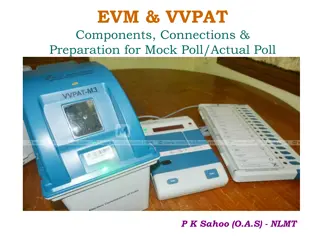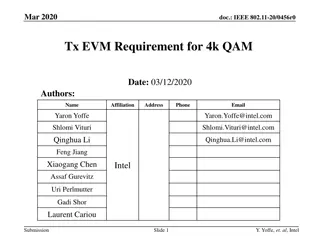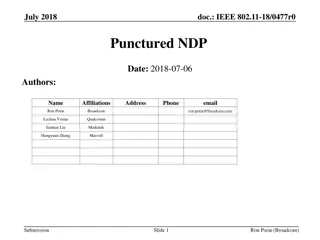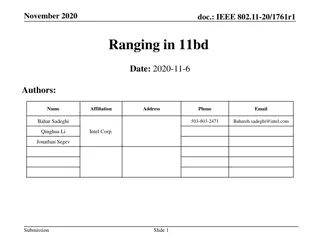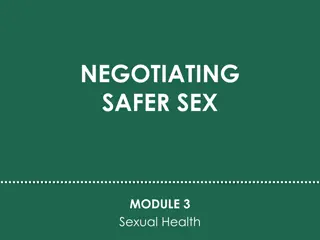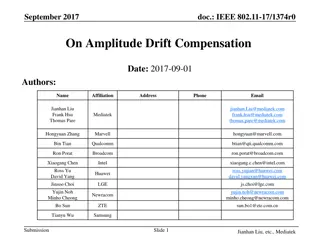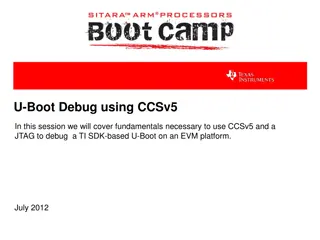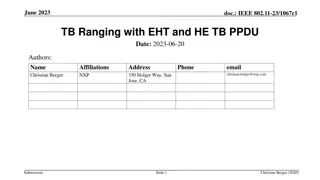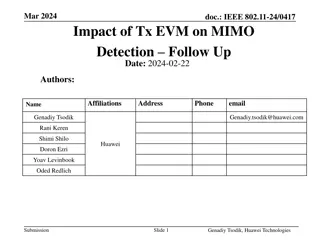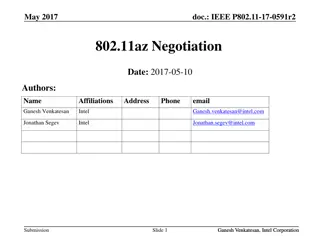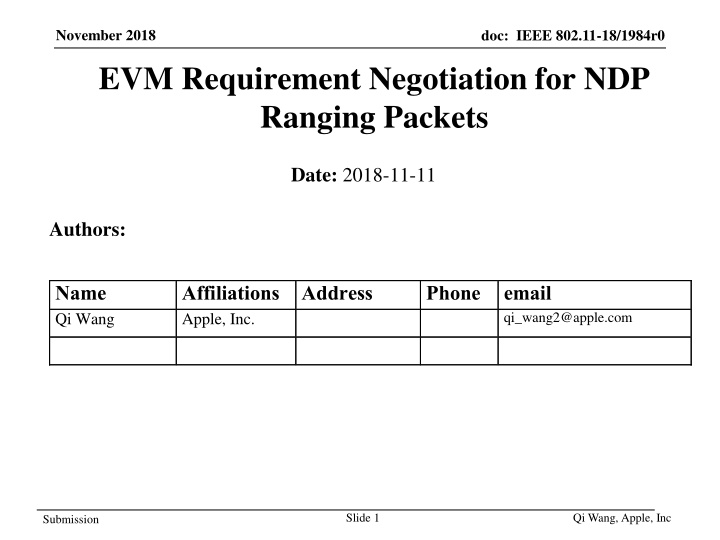
EVM Requirement Negotiation for IEEE 802.11 Wireless Networks
Explore the November 2018 documents on EVM requirement negotiation for NDP ranging packets in IEEE 802.11 standards. The documents discuss the impact of EVM levels on ranging accuracy, trade-offs between low and high EVM levels, and proposals for achieving desired accuracy in ranging sessions through EVM level transmissions.
Download Presentation

Please find below an Image/Link to download the presentation.
The content on the website is provided AS IS for your information and personal use only. It may not be sold, licensed, or shared on other websites without obtaining consent from the author. If you encounter any issues during the download, it is possible that the publisher has removed the file from their server.
You are allowed to download the files provided on this website for personal or commercial use, subject to the condition that they are used lawfully. All files are the property of their respective owners.
The content on the website is provided AS IS for your information and personal use only. It may not be sold, licensed, or shared on other websites without obtaining consent from the author.
E N D
Presentation Transcript
November 2018 EVM Requirement Negotiation for NDP Ranging Packets doc: IEEE 802.11-18/1984r0 Date: 2018-11-11 Authors: Name Qi Wang Affiliations Address Apple, Inc. Phone email qi_wang2@apple.com Slide 1 Qi Wang, Apple, Inc Submission
November 2018 doc: IEEE 802.11-18/1984r0 Problem Statement NDPs (null-data-packet) are used as the measurement frames for the TB and NTB ranging modes in 802.11az_D0.5 [1]. There are no EVM requirements for NDP in 802.11az_D0.5 [1] and 802.11-2016 [2]. NDP is a frame that has only the PHY header but does not contain the MAC data payload. The EVM requirement specified in [2] is a fixed value for a particular packet data rate, and is not negotiable. However, ranging accuracy is tightly coupled with EVM. Slide 2 Qi Wang, Apple, Inc Submission
November 2018 doc: IEEE 802.11-18/1984r0 Ranging Accuracy vs. EVM The result of our investigation: The ToA accuracy in a multipath environment is affected by the EVM level of the transmitted measurement frames. Ranging error decreases as the increasing EVM level (in absolute value). Advanced algorithms benefit from from EVM as much as - 40dB Ranging estimation error in multi-path channel. BW = 80Mhz 3 2.5 Relative raging error 2 1.5 1 0.5 0 10 15 20 25 30 35 40 - EVM [dB] Slide 3 Submission Qi Wang, Apple, Inc
November 2018 doc: IEEE 802.11-18/1984r0 Low/High EVM Trade off A higher EVM level improves ranging accuracy but usually requires the transmitter to reduce its output power and therefore limits the distance at which a ranging session can be performed. A lower EVM level degrades accuracy but enables the ranging operation at a further distance. Slide 4 Qi Wang, Apple, Inc Submission
November 2018 doc: IEEE 802.11-18/1984r0 Proposal In order to achieve a certain desired accuracy for a particular ranging session, an iSTA transmits its required/desired EVM level that rSTA should meet when transmitting the NDP measurement frames to the iSTA. When the iSTA transmits its required/desired EVM level, the iSTA also: Option 1: commits to meet such an EVM level in its own transmission to the rSTA. Option 2: indicates the actual EVM level of the transmission from iSTA to the rSTA. Slide 5 Qi Wang, Apple, Inc Submission
November 2018 doc: IEEE 802.11-18/1984r0 Proposal cont d The iSTA includes its desired/required EVM level in the Ranging Parameter field of the Ranging Parameter element in the Initial FTM Request frame The rSTA responds by including its actual EVM level, which is a level closest to what s requested by the iSTA and is supported by the rSTA, in the Ranging Parameter field of the Ranging Parameter element in the Initial FTM frame. The iSTA decides whether to continue or terminate the ranging session accordingly. New iSTA s EVM requirement / rSTA s acutal EVM Format and Bandwidth Number of Antennas ISTA2RSTA LMR Feedback Secure LTF Support Status Indication Secure LTF Required Value Bits: 2 1 6 8 6 1 5 1 Figure xxx: Ranging Parameters field format Slide 6 Qi Wang, Apple, Inc Submission
November 2018 doc: IEEE 802.11-18/1984r0 Proposal cont d The method that the iSTA uses to decide its EVM requirement is implementation specific. The iSTA may take the following information into account in generating the requirement: The use case for the ranging session The SNR at the iSTA The internal algorithm used by the iSTA to estimate the ToA of the NDPs Other internal factors. The method that the rSTA uses to decide its actual EVM level is implementation specific. Slide 7 Qi Wang, Apple, Inc Submission
November 2018 doc: IEEE 802.11-18/1984r0 Proposal Measurement Method A method for measuring EVM on NDPs needs to be defined. Suggested method: NDP EVM can be tested using a standard VSA (vector signal analyzer) device by measuring the L-Sig symbol s EVM on each of the Tx antennas. We verified this option exists in Agilent VSA device. Slide 8 Qi Wang, Apple, Inc Submission
November 2018 doc: IEEE 802.11-18/1984r0 Summary A mechanism for the iSTA and rSTA to negotiate the EVM requirement on the NDP transmission is proposed. The proposed method enables the selection of a suitable EVM level for a specific ranging session that has a desired ranging accuracy and operating distance. Slide 9 Qi Wang, Apple, Inc Submission
November 2018 doc: IEEE 802.11-18/1984r0 Straw Poll 1 Do you support to add a method to negotiate the EVM requirement on the NDP transmission within a ranging session? Results: Yes: No: Abstain: Slide 10 Qi Wang, Apple, Inc Submission
November 2018 doc: IEEE 802.11-18/1984r0 Straw Poll 2 Do you support to include the EVM requirement by iSTA and the actual EVM level of the rSTA using the method described on slide 6? Results: Yes: No: Abstain: Slide 11 Qi Wang, Apple, Inc Submission
November 2018 doc: IEEE 802.11-18/1984r0 References [1] IEEE Draft P802.11az_D0.5 - Draft Standard for Information Technology - Telecommunications and Information Exchange Between Systems Local and Metropolitan Area Networks - Specific Requirements Part 11: Wireless LAN Medium Access Control (MAC) and Physical Layer (PHY) Specifications - Amendment 8: Enhancements for Positioning [2] IEEE Std 802.11-2016 (Revision of IEEE Std 802.11-2012) - IEEE Standard for Information technology Telecommunications and information exchange between systems Local and metropolitan area networks Specific requirements - Part 11: Wireless LAN Medium Access Control (MAC) and Physical Layer (PHY) Specifications Slide 12 Qi Wang, Apple, Inc Submission




